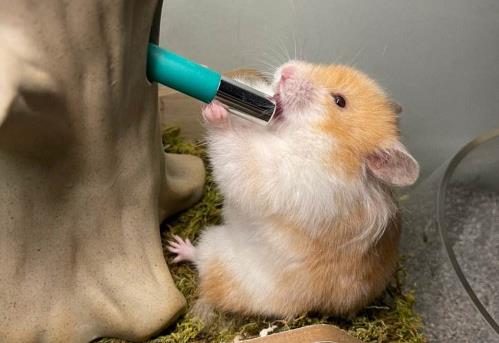Complete Supply List for Hamster Care

1. Basic Living Supplies
Hamster Cage: Choose the size based on the hamster breed. Dwarf hamsters require a minimum size of 47cm, while Syrian hamsters need a cage of 60cm or larger. Materials can be wire cages (bar spacing ≤ 1cm) or full-plastic cages (for warmth in winter).
Bedding: Use paper-based bedding or wood shavings (5–8cm thick) in winter, and corn cob bedding in summer. Do not use pine shavings (irritating odor) or printed paper (toxic ink).
Food Bowl: Ceramic to prevent tipping; a small dish can be used as a substitute.
Water Bottle: Ball-style water dispenser; replace with cooled boiled water daily.
2. Diet Management
Main Food: Choose professional hamster food (e.g., brands like Bunny, Pin Gao). Avoid low-quality mixed food.
Treats: Feed small pieces of carrot, broccoli, or apple (pitted). Offer 2–3 times a week, with each portion about the size of a fingernail.
Toxic Foods: Chocolate, citrus fruits, onions, etc. (all are toxic to hamsters).
3. Health & Grooming
Sand Bath/Bath Tub: Use sand bath (with a 15cm shallow tub) for dwarf hamsters; use dry cleaning powder for Syrian hamsters.
Teething Tools: Apple wood sticks or teething stones. Do not use disposable chopsticks.
Temperature Control: Maintain a temperature of 20–28°C. Use ice pads for cooling in summer and cotton nests for warmth in winter.
4. Exercise & Enrichment
Exercise Wheel: Seamless design. Choose a 17cm diameter wheel for dwarf hamsters and a 21cm or larger wheel for Syrian hamsters.
Toys: Wooden ladders, rope bridges, etc. DIY toys can be made to increase interactivity.
5. Other Essential Items
Litter Box: A small plastic box filled with cat litter; clean it daily.
Medical Preparations: Pet hospital contact card, deworming medicine, etc.
Notes
New hamsters need 3–7 days of quiet adaptation; co-housing is strictly forbidden.
Replace bedding every 5–7 days; clean food bowls and water bottles daily.
The above list ensures hamsters live in a comfortable and healthy environment.
